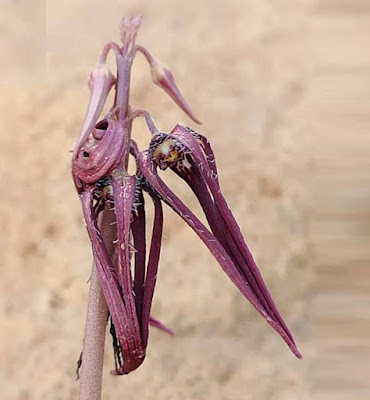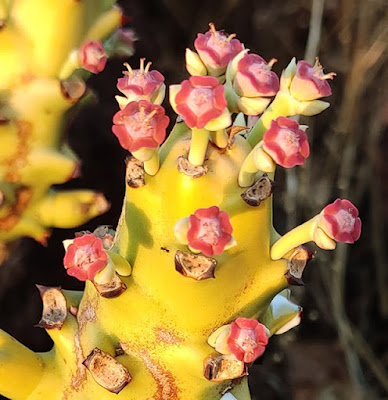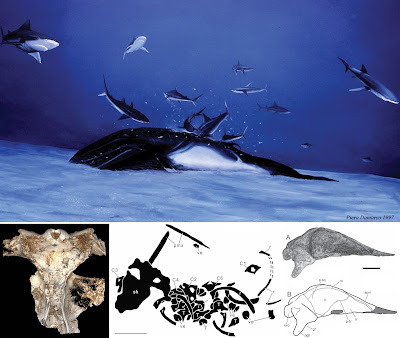[Most Recent Entries] [Calendar View]
Tuesday, September 7th, 2021
| Time | Event | ||
| 8:35a | [Botany • 2021] Brachystelma ananthagiriense (Apocynaceae: Asclepiadoideae) • A New Species from Ananthagiri hills, Telangana, India
Abstract A new species of Brachystelma, B. ananthagiriense is described and illustrated from the Ananthagiri hills of Vikarabad district, Telangana. The new species is closely similar to B. gondwanense but differs in a few attributes which are discussed. A detailed description, photographs and the conservation status of the new species are provided. Keywords: Ceropegieae, Deccan plateau, Hysteranthous Brachystelma ananthagiriense L. Paramesh, K. Prasad, Sadas. & A. Vijaya Bhasker Reddy sp. nov. Etymology: The species is named after type locality, Ananthagiri hills, Telangana. L. Paramesh, K. Prasad, B. Sadasivaiah and A. Vijaya Bhasker Reddy. 2021. Brachystelma ananthagiriense (Apocynaceae), A New Species from Ananthagiri hills, Telangana, India. Nordic Journal of Botany. DOI: 10.1111/njb.03003 | ||
| 8:47a | [Botany • 2021] Euphorbia lakshminarasimhanii (Euphorbiaceae) • A New Pygmy Succulent Species from Konkan Region of Maharashtra, India
Abstract Euphorbia lakshminarasimhanii (Euphorbiaceae), a new pygmy species belonging to the genus Euphorbia subg. Euphorbia sect. Euphorbia is described and illustrated from the Konkan region of Maharashtra, India. It is easily distinguished from all known Indian species by its unique sparsely-branched pygmy habit, closely spaced and horizontally flattened tubercles, trapezoidal spine shields which are very close and overlapping at the apical region, giving a pouch like appearance, bifurcated spines completely separated by the leaf scar, leaves forming a crown, long bracts extending past the gland edge, coral red colored glands with indented margins, male florets 10 per fascicle, and capsule having globose cocci with thin keels. Keywords: genus Euphorbia, Indian succulent euphorbia, new species, Old World Clade, section Euphorbia, subgenus Euphorbia, taxonomy Euphorbia lakshminarasimhanii Malpure, Chandore, P. S. Raut and B.DeJong sp. nov. Etymology: The species is named after the late plant taxonomist Dr. P. Lakshminarasimhan, for his prodigious and lasting contributions to Indian botany. Nilesh V. Malpure, Prashant S. Raut, Arun N. Chandore and Bruce E. De Jong. 2021. Euphorbia lakshminarasimhanii: A New Pygmy Succulent Species from Konkan Region of Maharashtra, India. Nordic Journal of Botany. DOI: 10.1111/njb.03142 | ||
| 10:41a | [PaleoMammalogy • 2021] Marzanoptera tersillae • A New Balaenopterid Genus and Species (Mysticeti: Balaenopteridae) from the Pliocene of Piedmont, north-west Italy
Abstract Marzanoptera tersillae gen. & sp. nov., a new balaenopterid from the Pliocene of the Piedmont in north-west Italy, is described based on a partial skeleton and compared with other living and fossil baleen whales. Marzanoptera tersillae shares characters, such as the shape of the supraoccipital, glenoid fossa of the squamosal and zygomatic process of the squamosal, with ‘Balaenoptera’ bertae. We used a computed tomography scan to view parts of the skull that were otherwise impossible to observe, such as the periotic. A phylogenetic analysis based on 355 character states scored from 87 taxa revealed a well-resolved hypothesis of relationships for Balaenopteridae and a general phylogenetic hypothesis for chaeomysticetes. The monophyly of all superfamily- and family-rank clades and of crown balaenopterid species was confirmed. In addition, a monophyletic group including most basal thalassotherian taxa was recovered. The mollusc fauna associated with the specimen was autochtonous and constituted a residual fossil assemblage indicative of an environmental context located below the base of the storm wave, characterized by a low-energy hydrodynamic regimen. Many shark teeth have been found in close association or embedded within the bones, suggesting a possible scavenging action by two shark species on the whale carcass. Keywords: Balaenopteridae, phylogeny, taphonomy, whale falls SYSTEMATIC PALAEONTOLOGY Class Mammalia Linnaeus, 1758 Order Cetacea Brisson, 1762 Suborder Mysticeti Flower, 1865 Infraorder Chaeomysticeti Mitchell, 1989 Parvorder Balaenomorpha Geisler & Sanders, 2003 Superfamily Thalassotherii Bisconti, Lambert & Bosselaers, 2013 Epifamily Balaenopteroidea Gray, 1868 Family Balaenopteridae Gray, 1864 Genus Marzanoptera gen. nov. Etymology: The genus name is composed of Marzano-, shortened from San Marzanotto, the locality of the discovery of the holotype skeleton, and the Greek φτερό, wing, referring to the wide and long forearms of balaenopterid whales. Marzanoptera tersillae sp. nov. Etymology: The fossil skeleton was discovered by Tersilla Argenta, for whom it was named. Holotype: Specimen 207.13307 of the inventory of EGPPA-MPTA institution in Asti. The specimen includes most of the skull, with one periotic in articulation, seven vertebrae and nine ribs. Michelangelo Bisconti, Piero Damarco, Marco Pavia, Barbara Sorce and Giorgio Carnevale. 2021. Marzanoptera tersillae, A New Balaenopterid Genus and Species from the Pliocene of Piedmont, north-west Italy. Zoological Journal of the Linnean Society. 192(4); 1253–1292. DOI: 10.1093/zoolinnean/zlaa131 |
| << Previous Day |
2021/09/07 [Calendar] |
Next Day >> |










